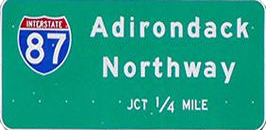 |
Interstate 87: Adirondack Northway
This Website is Now Over 19 Years Old. |
 |
Interstate 87: Adirondack Northway
This Website is Now Over 19 Years Old. |
The Adriondack's roads, with the exception of the Northway I-87, are 2 lane state country highways. As far as state highways go, they are great roads, say compared to state highways in Pennsylvania or Connecticut or even in other parts of NY. The routes are well marked, posted and banked and are usually in good repair. Route 30 has an extra wide space cleared back from the road on each side to reduce the chance of collisions, especially with deer. Outside of villages and hamlets, it's almost always posted 55 mph. If the route has one or two numbers, like our NY Route 30 or 67, 29, 28, 12, 10, 8, 7, 2 it will be a major road. Three number state routes, like 421, 334, are connector roads and they will be short and usually have tighter bends and curves. County routes are good too, but a notch below state highway standards. Fulton and Franklin Counties have great county roads, get a good county map. Town roads can get real basic though, unpaved and often sparsely cleared in the winter. Remember, town roads are crowned or the center of the road is higher than the sides, so on a left bend, you'll have a negative bank that can throw you off the road. It goes without saying that you should never drink and drive. Any Columbus DUI attorney knows that the majority of accidents involving DUI occur on rural roads.
Stay in the right lane except to pass, let faster cars go by. Be conscious that outside villages and hamlets on 2 lane roads, the speed limit is 55 mph, uless posted. If you feel uncomfortable driving at high speeds, don't hog the road. Pull over and let others by. A lot of people will take the pass and the harder you make it on them, the harder they'll make it for you. Nobody needs a low speed nanny! Space is a driver's best friend, and there is no shortage of that in the 'Daks.
Before you head to the Adirondack Mountains, make sure all four brakes are good. A common problem is that rear brakes get out of adjustment and the front brakes do all the work. The car will dive under heavy braking and the fronts rotors will warp and the pads will burn out quickly. Front brakes are easy to fix and is usually a simple d.i.y. job. Rear brakes, however, are a more difficult job and they should be left to a pro if you're a novice. The rear brakes usually self-adjust when the parking brake is used. If you never use the parking brake, chances are that your rear brakes aren't doing their share of the work. This happens a lot with automatic transmission cars because the parking brake usually never gets used. If the brake pedal feels low and the car dives under heavy braking, check and adjust the rear brakes by working the parking brake mechanism. Many older American cars have really poor parking brake cables subject to rust, so if you haven't used it in a while, don't force it or they'll lock up on you. Get new cables if the old ones are shot and lube any external linkages. Make sure your parking brake is fully operational and can hold the car alone on a steep hill. The best way is to adjust a rear drum brake by "spooning" the brake adjustor wheel through the slot in the backing plate. Make sure to cover the slot hole with it's rubber cover or a piece of foam if the cover is missing. Adjust the slack on the parking brake assembly after you adjust the rear brakes. Ohay that info is rather dated sine most cars have 4 wheel disk brakes. But even most of the 4 wheel disk brake cars, the actual rear parking brake is a small drum brake under the larger regular disc brake, If you have front wheel drive, parking with the parking brake means all four wheels are locked, which is very safe!
If you break down in a remote place, stay with the car unless you are prepared for the bitter elements (like winter parka, wool pants and sweater, winter lined boots, etc.). Don't continually run the motor. Use blankets and body heat for warmth, keep some candles to burn. If you run the motor for heat, leave the windows open a crack and make sure the tailpipe is blowing the exhaust gas up through the snow. Make a hole in the snow for the exhaust gas if necessary! Avoid deadly carbon monoxide poisoning! That happens when the snow traps the exhaust gas under the car and it rises into the cab. Prepare a winter kit, with tools, sleeping bag, food and fullsize spare tire ahead of time. In the old days they had emergency phones on the Northway which almost never worked anyways, but now with cellphones, being stranded is not as lonely. Remember though, there are dead spots on the Northway for cell service.